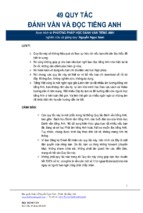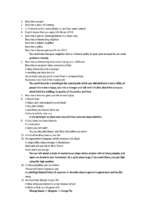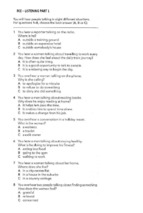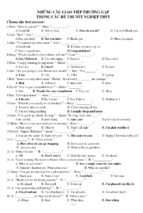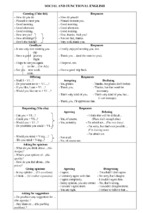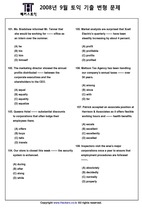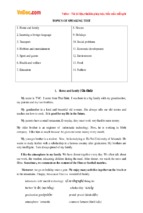goo
f
oof
r
p
-
BUSINESS
WRITING
L a u re n S t a r k e y
®
N
E W
Y
O R K
CONTENTS
Introduction
SECTION ONE
The Goof-Up—Disorganized Writing
1
Rule #1 Spend Time Prewriting
2
Rule #2 Choose an Appropriate Organization Method
4
Rule #3 Transform Prewriting into an Outline
5
Rule #4 Use Appropriate Headings and Salutations
7
Rule #5 Write a Strong Introduction
9
Rule #6 Use the Body of Your Writing to Present
Supporting Information
11
Rule #7 End with an Effective Conclusion
13
Rule #8 Use an Appropriate Closing
15
Thuvientailieu.net.vn
viii
g o o f - p ro o f
BUSINESS WRITING
SECTION TWO
The Goof-Up—Being Unaware of Your Audience
17
Rule #9 Adapt Your Writing to Deal
with Multiple Audiences
18
Rule #10 Learn about Your Audience
20
Rule #11 Establish a Positive Impression
with Your Audience: Tone
22
Rule #12 Establish a Positive Impression
with Your Audience: Voice
24
Rule #13 Choose Words with Your Audience in Mind
25
Rule #14 Use the Correct Format
27
Rule #15 Remember the Human Element
30
Rule #16 Understand Your Audience’s Level
of Understanding, and Write to It
32
SECTION THREE
The Goof-Up—Writing without Clarity
35
Rule #17 Know What You Want to Say
Before You Say It
36
Rule #18 Choose the Right Words
37
Rule #19 Eliminate Ambiguity
39
Rule #20 Avoid Unclear Pronoun References
41
Rule #21 Be Brief
43
Rule #22 Don’t Repeat Yourself
46
SECTION FOUR
The Goof-Up—Choosing the Wrong Words
49
Rule #23 Learn the Most Commonly Confused
Words, and Use Them Properly
51
Rule #24 Learn the Most Misused Words,
and Use Them Properly
54
Rule #25 Don’t Use Words That Aren’t Really Words
57
Thuvientailieu.net.vn
Contents
Rule #26 Don’t Use Words or Phrases
That Might Offend Your Reader
59
Rule #27 Understand Positive and Negative
Connotations to Choose Words Wisely
61
Rule #28 It Doesn’t Always Pay to Be Wise
63
Rule #29 Don’t Sound Like a Robot
64
Rule #30 Formality versus Informality
66
Rule #31 Avoid Colloquialisms
68
Rule #32 Don’t Bewilder Your Readers with Jargon
70
SECTION FIVE
The Goof-Up—Not Understanding
the Basic Mechanics of Writing
75
Rule #33 Remember the Parts of Speech
76
Rule #34 Avoid Dangling Participles
and Misplaced Modifiers
83
Rule #35 Noun/Verb Agreement
85
Rule #36 Active versus Passive Voice
87
Rule #37 Sentence Fragments and Run-on Sentences
89
Rule #38 Verb Tense Shifts
91
Rule #39 Double Negatives
92
Rule #40 Don’t Make Spelling Mistakes
94
Rule #41 Use Punctuation Marks Correctly
102
Rule #42 Don’t Overuse Capital Letters
110
SECTION SIX
The Goof-Up—Confusing the Types
of Business Writing
113
Rule #43 Get E-mails in Order
115
Rule #44 Perfect Your Business Letters
119
Rule #45 Get Your Memos into Shape
128
Thuvientailieu.net.vn
ix
x
g o o f - p ro o f
BUSINESS WRITING
Rule #46 Write Agendas That Lead to Better Meetings
133
Rule #47 Professional Proposals Get Noticed
136
Rule #48 Details Matter in Reports
141
Rule #49 Thank You Letters Are Good Business
148
Rule #50 Be Precise When Writing Instructions
or Directions
151
SECTION SEVEN: RESOURCES
Appendix A:
Using Computer Formatting, Grammar,
and Spelling Tools
159
161
Appendix B:
Online Resources
165
Appendix C:
Print Resources
169
Appendix D:
Answer Key
173
Thuvientailieu.net.vn
INTRODUCTION
Even if you have the education and experience necessary to get a good job, inadequate writing skills could hold you
back. Why? Because you need good writing skills to convey your
knowledge and experience. Poor written communications can
make you appear less competent than you are, and keep your
ideas from getting the audience—and the praise—they deserve.
Learning how to write in a clear, organized, and error-free manner is what Goof-Proof Business Writing is all about. In the following chapters, the basics of good writing, from organization to
mechanics, are broken down into 50 simple Goof-Proof Rules.
Follow them, and you will be led step-by-step toward better
workplace communications.
●
HOW THE GOOF-PROOF METHOD WORKS
●
The 50 Goof-Proof Rules are presented in Goof-Up form. You will
read about a common mistake, then learn how to Goof-Proof
yourself, or avoid the mistake. Goof-Proof Business Writing covers everything you need to know to improve your writing:
Thuvientailieu.net.vn
xii
g o o f - p ro o f
•
•
•
•
•
BUSINESS WRITING
how to organize your thoughts
targeting your audience and writing to them
knowing what you want to say and saying it clearly
using the right format for you communication
choosing the right words to get your point across
Writing well also means following the rules of grammar and
spelling. Although most business communications are written on
a computer with grammar and spell checks, these high-tech
helpers aren’t goof-proof. You still need to know the basic
mechanics in order to write well. The five Goof-Proof Rules of
mechanics will explain simply and directly the information you
need to know.
The book is divided into seven sections, each covering a different writing topic:
• Section One explains the importance and how-to’s of organizing your ideas, and writing effective introductions, bodies,
and conclusions.
• Section Two teaches you how to write directly to your audience by understanding who they are and giving them the
right amount of information.
• Section Three is all about clarity. Determine exactly what
you want to say and how to say it in the most direct, specific, and unambiguous way.
• Section Four explains the importance of word choice. You
will learn how to correctly use the most confused and misused words, and how to avoid alienating or baffling your
audience through improper word choices.
• Section Five gets back to basics. The parts of speech and
common grammatical errors are explained, and made GoofProof. Spelling, punctuation marks, and capitalization are
also covered.
• Section Six shows you eight of the most common business
writing formats, and how to use them correctly. You will
learn how to write agendas, letters, e-mails, memos, reports,
instructions, and proposals, and see samples of each.
Thuvientailieu.net.vn
I n t ro d u c t i o n
• Appendices: Finally, find more grammar, spelling, and writing resources, along with information on how to take full
advantage of your computer’s formatting, grammar, and
spelling tools.
As you read Goof-Proof Business Writing, remember that your
written communications say a lot about you. If they are poorly
organized, full of spelling mistakes, or use offensive language, you
will appear less than professional, and whatever you have to say
will probably be lost in the confusion. Don’t allow your business
reputation to suffer because of poor grammar or word choice.
Writing well is a skill that can be acquired at any time, and is made
simple in this Goof-Proof book.
After using this book and mastering the Goof-Proof Rules,
your writing will improve. You will know how to get right to the
point, using the right words and the right format. And your workplace audience will appreciate your efforts—you are writing to
busy people, who don’t have time to figure out what you are trying to say. By getting it right the first time, your ideas and efforts
will be rewarded with understanding, and your professional
image will improve, too.
Thuvientailieu.net.vn
xiii
Thuvientailieu.net.vn
goof-proof
BUSINESS WRITING
Thuvientailieu.net.vn
Thuvientailieu.net.vn
section
ONE
THE GOOF-UP:
DISORGANIZED WRITING
Good business writing
begins with organization. Even the shortest e-mail benefits from time spent developing your ideas. Prewriting or brainstorming becomes even
more important when you are writing something longer, such as
a report, involving a variety of issues and ideas. The notes taken
during the prewriting stage should then be transformed into an
outline, which helps set the direction of your writing. Finally,
before you write, organize your information logically.
Remain organized during the writing process. Follow your outline, using it to write a topic sentence and then a strong introduction. In the body of your communication, bring up all of the
relevant points you organized earlier, and conclude by leaving
your reader with a firm understanding of your subject, argument,
or analysis. Adhere to the etiquette of business writing by using
appropriate headings and conclusions in all of your letters,
memos, reports, and even e-mails.
Thuvientailieu.net.vn
2
g o o f - p ro o f
BUSINESS WRITING
RULE #1: Spend Time Prewriting
There are two simple steps to Goof-Proof prewriting: determining
the purpose of your communication and exploring your subject on
paper.
●
GOOF-PROOF IT!
●
Before you begin writing, specify these three things:
1. the action of your message
2. the object of that action (the what)
3. the receiver of that action (the who)
Then, write down all of your ideas about the what that you
believe the who should know.
To prewrite effectively, answer four key questions. You might
want to set up four columns on a piece of paper, one each for
purpose, action, object of the action, and receiver of the action.
Or, you may prefer to simply jot down the questions and answers:
1.
2.
3.
4.
What is the purpose of my writing?
What is the action?
What is the object?
What/who is the receiver of the action?
This table shows a few simple examples of the four-column
method of determining your writing goal.
PURPOSE
ACTION
welcome the
new employees
to welcome
explain the
new policy
to explain
report a violation to report
of procedures
OBJECT OF THE
ACTION
RECEIVER OF
THE ACTION
the new
employees
the new policy
employees
violation
management
Thuvientailieu.net.vn
D i s o r g a n i z e d Wr i t i n g
Once you’ve come up with a goal, get your ideas down on
paper. They can be in the form of a neat list, moving from the
most to least important, or they can be random, needing more
organization later.
●
GOOF-PROOF RULE OF THUMB
●
Logic and organization aren’t important in prewriting. The goal is
to be thorough. Explore your subject on paper, toss out ideas,
identify points to be made, and consider arguments in favor of—
or even against—your point of view.
●
GOOF-PROOF SAMPLE
PREWRITING NOTES
●
In this example, the subject has been asked by his boss to write
a memo about a recent meeting they both attended. He needs to
explain the important details to the rest of his department. Before
writing the memo, he makes a list of ideas for possible inclusion.
Department needs more manpower—
Management considering hiring two assistants
Who would use new assistants?
Last two presentations not accepted by clients—why?
Not enough time to come up with good material?
Client not specific about what she wanted ahead of time?
New graphic software not being used by everyone in Creative
Department—
Too time consuming to learn?
Many prefer old software?
Too difficult to master?
Thuvientailieu.net.vn
3
4
g o o f - p ro o f
BUSINESS WRITING
RULE #2: Choose an Appropriate
Organization Method
Make sense out of your prewriting notes by using a method that is
appropriate to your subject and the purpose of your writing.
●
GOOF-PROOF IT!
●
Here are five proven organizing strategies for your notes:
1. Order of importance: Rank supporting ideas from most
important to least important, or vice versa.
2. Chronological: Organize your ideas in the order in which
they did happen or will happen.
3. Cause and Effect: Explain what happened (cause) and what
happened as a result (effect), or vice versa.
4. List: Create a roster of items of equal importance.
5. General to Specific: State supporting details, then the main
point, or vice versa.
●
GOOF-PROOF SAMPLE ●
SPECIFIC TO GENERAL ORGANIZATION
Shakira is an excellent employee, and deserves a raise.
hasn’t had pay increase for 2 years
no sick days taken
works well with others
regularly meets or exceeds individual production goals
volunteers to help others
Thuvientailieu.net.vn
D i s o r g a n i z e d Wr i t i n g
RULE #3: Transform Prewriting into an Outline
Never waste prewriting work—organize it logically into a working
outline by creating major and minor topics.
●
GOOF-PROOF IT!
●
Creating an outline begins with a reading of your prewriting
notes. First, group related ideas together, looking for major topics (which can be headings), and minor ones (which can be subheadings, examples, or details).
Start by defining your major points, and rearrange them until
they make sense and follow a logical progression. You will be
able to see the relationships between your ideas as you outline
them and determine their importance (major point, minor point,
example, or detail). If you need more supporting details or facts—
subcategories—you can add them now.
●
GOOF-PROOF RULE OF THUMB
●
As you outline your information, use topics, which are one-word
or short phrases, or write out full sentences for each point on your
outline.
●
GOOF-PROOF SAMPLE
STANDARD OUTLINE
●
A standard outline form using Roman and Arabic numerals and
upper and lower case letters looks like this:
I.
A.
B.
1.
2.
a.
b.
Thuvientailieu.net.vn
5
6
g o o f - p ro o f
BUSINESS WRITING
●
GOOF-PROOF SAMPLE ●
NOTES TRANSFORMED INTO OUTLINE FORM
These are notes taken by a senior account representative during
a meeting with a client.
At meeting: Marge L., Larry D., Lily M., Jeremy V.
Ideas for expanding company product list
• Marge: must appeal to a younger demographic
• Jon: will research trends online
New benefits program
• New HMO
• Free dental coverage for all employees
New incentive plan
• Holiday bonuses
Objectives: everyone will come up with five ideas for the next
meeting
Here are the same notes organized into an outline that describes
the senior account representative’s understanding of the facts after
meeting with a client.
I. Overview
A. List meeting attendees
B. New product ideas
1. Appeal to younger demographic
2. Research trends
II. Discussion of Topics
A. New benefits program
1. New HMO
2. Free dental coverage for all employees
B. New incentive plan
1. Holiday bonuses
III. Business Objectives
Thuvientailieu.net.vn
D i s o r g a n i z e d Wr i t i n g
RULE #4: Use Appropriate Headings
and Salutations
Business writing is all about fitting in. Standard headings and
salutations should be used at all times.
●
GOOF-PROOF IT!
●
For business letters, a standard heading includes (in this order):
•
•
•
•
•
writer’s address
date
recipient’s address
re: or subject line
salutation
●
GOOF-PROOF CHECKLIST ●
BASIC GUIDELINES FOR SALUTATIONS
OR GREETINGS
✓ Begin with the word “Dear.”
✓ If you are not on a first-name basis with the reader, use
Mr./Ms./Mrs. and the reader’s last name (Dear Mr. Jones).
✓ If you are on a first-name basis, use his or her first name
(Dear Janine).
✓ If you don’t know the reader’s name, use his or her title
(Dear Customer Service Representative).
✓ If you don’t know the reader’s gender, use Mr./Ms. ___
(Dear Mr./Ms. Jones).
✓ Follow the salutation with a colon (:).
Thuvientailieu.net.vn
7
8
g o o f - p ro o f
BUSINESS WRITING
For memos, a heading is used without a separate salutation.
It should include these five parts, in order:
1.
2.
3.
4.
5.
to
from
date
re: or subject line
cc
●
To:
GOOF-PROOF SAMPLE
MEMO HEADING
●
M. Kaur
From: E. Sicalowski
Date:
September 15, 2003
Re:
Sample Acquisition
cc:
D. Thomas, W. Wei
For e-mails, there is no need to create a separate heading
because all e-mail software creates headings automatically. Heading information includes the subject line you provide, the recipient, the sender, and the date. Never leave out a subject line, and
always follow the salutation guidelines for letters. If you are writing to a business associate who is also a friend, his or her name
followed by a comma or colon is appropriate.
Thuvientailieu.net.vn
D i s o r g a n i z e d Wr i t i n g
RULE #5: Write a Strong Introduction
Especially important for longer letters and memos, an introduction
prepares your audience to hear what you have to say.
●
GOOF-PROOF IT!
●
Begin by writing a topic sentence, based on your prewriting goal
and the major points of your outline. Then, determine whether
you intend to argue a point, explain or present your subject, or
analyze your subject.
If you are arguing a point, your introduction should state your
claim in a topic sentence, give some of the explanations and evidence you will present, and give an order to your argument.
●
GOOF-PROOF SAMPLES ●
ARGUMENTATIVE INTRODUCTORY SENTENCES
Product A has been a best seller for our company for the past three years,
but we should spend the resources necessary to create Product B.
Although the team wants to keep it on our calendar, the meeting scheduled for next Tuesday will not help us meet our objectives if the client does
not attend.
●
GOOF-PROOF RULE OF THUMB
●
An introduction has three purposes:
1. to tell the reader what the communication is about (the
subject)
2. to let the reader know what you think, feel, or know about
that subject (the main idea)
3. to catch the reader’s attention (so he or she actually reads
what you wrote)
Thuvientailieu.net.vn
9
- Xem thêm -









